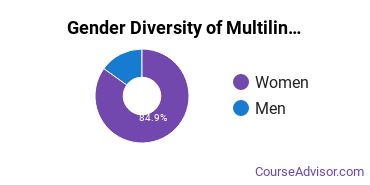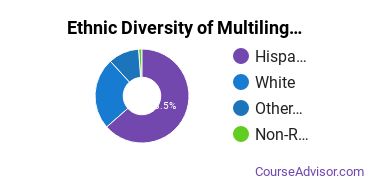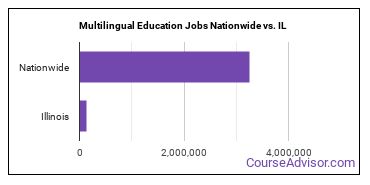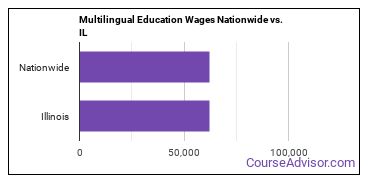Multilingual Education Schools in Illinois
In 2022-2023, 79 students earned their Multilingual Education degrees in IL.
In terms of popularity, Multilingual Education is the 165th most popular major in the state out of a total 306 majors commonly available.
Education Levels of Multilingual Education Majors in Illinois
Multilingual Education majors in the state tend to have the following degree levels:
| Education Level | Number of Grads |
|---|---|
| Master’s Degree | 68 |
| Bachelor’s Degree | 6 |
| Post-Master’s Certificate | 5 |
| Postbaccalaureate Certificate | 5 |
Gender Distribution
In Illinois, a multilingual education major is more popular with women than with men.

Racial Distribution
The racial distribution of multilingual education majors in Illinois is as follows:
- Asian: 2.5%
- Black or African American: 0.0%
- Hispanic or Latino: 67.1%
- White: 25.3%
- Non-Resident Alien: 1.3%
- Other Races: 3.8%

Jobs for Multilingual Education Grads in Illinois
138,640 people in the state and 3,261,420 in the nation are employed in jobs related to multilingual education.

Wages for Multilingual Education Jobs in Illinois
Multilingual Education grads earn an average of $62,140 in the state and $62,030 nationwide.

Most Popular Multilingual Education Programs in IL
There are 9 colleges in Illinois that offer multilingual education degrees. Learn about the most popular 9 below:
99% of students get financical aid. An average student at Roosevelt will pay a net price of $21,110. Most students complete their degree in 4.33 years.
Request InformationThe full-time teacher rate is 49%. This private school has an average net price of $29,430. 99% of students get financical aid.
Request Information100% of students get financical aid. This private institution charges an average net price of $17,553. Of all the teachers who work at the school, 100% are considered full time.
Request Information12 to 1 is the student to faculty ratio. Students who attend this private institution pay an average net price of $18,256. Most students complete their degree in 4.30 years.
Request InformationMost students complete their degree in 4.13 years. The full-time teacher rate is 50%. 13 to 1 is the student to faculty ratio.
Request Information100% of students get financical aid. Students enjoy a student to faculty ratio of 14 to 1. It takes the average student 4.18 years to graduate.
Request InformationThis public school has an average net price of $13,209. The average student takes 5.11 years to complete their degree at Northeastern Illinois University. The student to faculty ratio is 9 to 1.
Request Information100% of students get financical aid. The average student takes 4.23 years to complete their degree at Dominican U. An average student at Dominican U will pay a net price of $17,768.
Request InformationThis public school has an average net price of $6,916. It takes the average student 4.97 years to graduate. The student to faculty ratio is 11 to 1.
Request InformationMultilingual Education Careers in IL
Some of the careers multilingual education majors go into include:
| Job Title | IL Job Growth | IL Median Salary |
|---|---|---|
| High School Teachers | 4% | $67,680 |
| Elementary School Teachers | 4% | $59,070 |
Related Majors in Illinois
Below are some popular majors in the state that are similar to multilingual education.
| Major | Annual Graduates in IL |
|---|---|
| Teacher Education Grade Specific | 3,473 |
| Educational Administration | 1,825 |
| Teacher Education Subject Specific | 1,676 |
| Special Education | 1,153 |
| Curriculum & Instruction | 1,019 |
| General Education | 453 |
| Student Counseling | 336 |
| Instructional Media Design | 181 |
View all majors related to Multilingual Education
Explore Major by State
Alabama
Arkansas
Connecticut
Florida
Idaho
Iowa
Louisiana
Massachusetts
Mississippi
Nebraska
New Jersey
North Carolina
Oklahoma
Rhode Island
Tennessee
Vermont
West Virginia
View Nationwide Multilingual Education Report
References
- College Factual
- National Center for Education Statistics
- O*NET Online
- Image Credit: By DIAC images under License
More about our data sources and methodologies.









